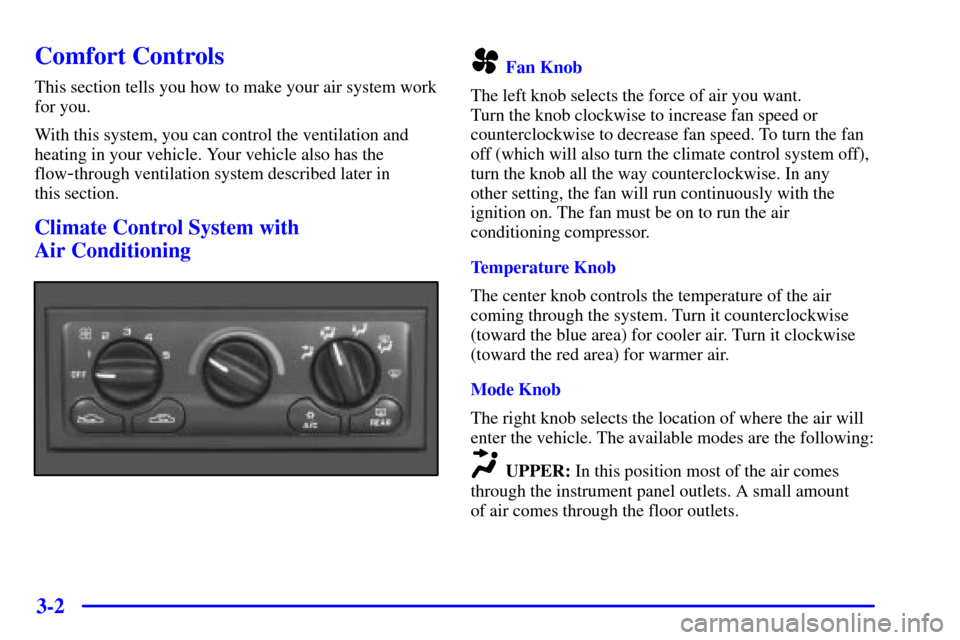Page 95 of 351

2-30
Engine Exhaust
CAUTION:
Engine exhaust can kill. It contains the gas
carbon monoxide (CO), which you can't see or
smell. It can cause unconsciousness and death.
You might have exhaust coming in if:
�Your exhaust system sounds strange
or different.
�Your vehicle gets rusty underneath.
�Your vehicle was damaged in a collision.
�Your vehicle was damaged when driving over
high points on the road or over road debris.
�Repairs weren't done correctly.
�Your vehicle or exhaust system had been
modified improperly.
If you ever suspect exhaust is coming into
your vehicle:
�Drive it only with all the windows down to
blow out any CO; and
�Have your vehicle fixed immediately.
Running Your Engine While
You're Parked
It's better not to park with the engine running. But if you
ever have to, here are some things to know.
CAUTION:
Idling the engine with the climate control
system off could allow dangerous exhaust into
your vehicle. See the earlier Caution under
ªEngine Exhaust.º
Also, idling in a closed-in place can let deadly
carbon monoxide (CO) into your vehicle even if
the fan switch is at the highest setting. One place
this can happen is a garage. Exhaust
-- with
CO
-- can come in easily. NEVER park in a
garage with the engine running.
Another closed-in place can be a blizzard.
See ªBlizzardº in the Index.
Page 114 of 351
2-49
The main components of your instrument panel are the following:
A. Side Window Defogger Vents
B. Vent Outlets
C. Instrument Panel Brightness Control
D. Fog Lamp Button (If Equipped)
E. Turn Signal/Multifunction Lever
F. Cruise Control Buttons (If Equipped)
G. Instrument Panel Cluster
H. Windshield Wiper/Washer Lever
I. Ignition Switch
J. Hazard Warning Flashers Button
K. Instrument Panel Fuse BlocksL. Instrument Panel Cupholder
M. Remote Trunk Release Button
N. Hood Release
O. Tilt Wheel Lever
P. Parking Brake
Q. Horn
R. Audio System
S. Cigarette Lighter
T. Ashtray
U. Accessory Power Outlet
V. Climate Control System
Page 132 of 351

3-
3-1
Section 3 Comfort Controls and Audio Systems
In this section, you'll find out how to operate the comfort control and audio systems offered with your vehicle.
Be sure to read about the particular systems supplied with your vehicle.
3
-2 Comfort Controls
3
-2 Climate Control System with
Air Conditioning
3
-4 Air Conditioning
3
-4 Heating
3
-5 Defogging and Defrosting Windows
3
-6 Rear Window Defogger
3
-6 Ventilation System
3
-7 Audio Systems
3
-7 Setting the Clock for Systems without Radio
Data System
3
-8 Setting the Clock for Systems with Radio
Data System
3
-8AM-FM Stereo
3
-11 AM-FM Stereo with Cassette Tape Player
with Radio Data System (RDS) and Automatic
Tone Control (If Equipped)3
-20 AM-FM Stereo with Compact Disc Player
with Radio Data System (RDS) and Automatic
Tone Control (If Equipped)
3
-27 AM-FM Stereo with Cassette Tape and
Compact Disc Player with Radio Data
System (RDS) and Automatic Tone
Control (If Equipped)
3
-38 Personal Choice Radio Controls (If Equipped)
3
-38 Theft-Deterrent Feature
3
-39 Understanding Radio Reception
3
-39 Tips About Your Audio System
3
-40 Care of Your Cassette Tape Player
3
-41 Care of Your Compact Discs
3
-41 Care of Your Compact Disc Player
3
-41 Fixed Mast Antenna
3
-41 Chime Level Adjustment
Page 133 of 351

3-2
Comfort Controls
This section tells you how to make your air system work
for you.
With this system, you can control the ventilation and
heating in your vehicle. Your vehicle also has the
flow
-through ventilation system described later in
this section.
Climate Control System with
Air Conditioning
Fan Knob
The left knob selects the force of air you want.
Turn the knob clockwise to increase fan speed or
counterclockwise to decrease fan speed. To turn the fan
off (which will also turn the climate control system off),
turn the knob all the way counterclockwise. In any
other setting, the fan will run continuously with the
ignition on. The fan must be on to run the air
conditioning compressor.
Temperature Knob
The center knob controls the temperature of the air
coming through the system. Turn it counterclockwise
(toward the blue area) for cooler air. Turn it clockwise
(toward the red area) for warmer air.
Mode Knob
The right knob selects the location of where the air will
enter the vehicle. The available modes are the following:
UPPER: In this position most of the air comes
through the instrument panel outlets. A small amount
of air comes through the floor outlets.
Page 134 of 351

3-3
BI-LEVEL: In this position the air comes
through the instrument panel outlets and through the
floor outlets.
FLOOR: In this position most of the air comes
through the floor outlet. The rest of the air comes
through the windshield and side window outlets.
DEFOG: This position divides the air between
the floor outlets and the windshield defroster outlet.
The air conditioning compressor will run automatically
in this position when it is needed to help dry the air in
the vehicle.
DEFROST: This position directs most of the air
through the windshield defroster outlet. Some of the air
goes to the floor outlets. The air conditioning
compressor will run automatically in this position when
it is needed to help dry the air in the vehicle.
Mode Buttons
A/C: Press A/C to operate the air conditioner
compressor. The indicator light will glow when the
button is pressed to indicate that the air conditioning
system has been requested.
OUTSIDE AIR: Press this button to allow the
circulation of outside air in the vehicle. The indicator
light on the button will glow when pressed. OUTSIDE
AIR is available in all modes including OFF. OUTSIDE
AIR is the default setting and is automatically activated
in DEFOG and DEFROST or when turning the climate
control system on or turning the ignition switch from
OFF to ON.
Pressing this button will cancel the
RECIRCULATION button.
RECIRCULATION: Press this button to limit
the amount of outside air entering your vehicle. This is
also helpful when you are trying to limit odors entering
your vehicle. The indicator light on the button will glow
when it is pressed. RECIRCULATION is available in all
modes, except DEFOG and DEFROST.
Pressing this button will cancel the
OUTSIDE AIR button.
It is not recommended to use this button in the FLOOR
mode with heat. It is useful to quickly cool the vehicle
on hot days.
Page 281 of 351

6-42 Uniform Tire Quality Grading
Quality grades can be found where applicable on the tire
sidewall between tread shoulder and maximum section
width. For example:
Treadwear 200 Traction AA Temperature A
The following information relates to the system
developed by the United States National Highway
Traffic Safety Administration, which grades tires by
treadwear, traction and temperature performance. (This
applies only to vehicles sold in the United States.) The
grades are molded on the sidewalls of most passenger
car tires. The Uniform Tire Quality Grading system
does not apply to deep tread, winter
-type snow tires,
space
-saver or temporary use spare tires, tires with
nominal rim diameters of 10 to 12 inches (25 to 30 cm),
or to some limited
-production tires.
While the tires available on General Motors passenger
cars and light trucks may vary with respect to these
grades, they must also conform to federal safety
requirements and additional General Motors Tire
Performance Criteria (TPC) standards.Treadwear
The treadwear grade is a comparative rating based on
the wear rate of the tire when tested under controlled
conditions on a specified government test course.
For example, a tire graded 150 would wear one and
a half (1 1/2) times as well on the government course
as a tire graded 100. The relative performance of tires
depends upon the actual conditions of their use,
however, and may depart significantly from the norm
due to variations in driving habits, service practices and
differences in road characteristics and climate.
Traction
-- AA, A, B, C
The traction grades, from highest to lowest, are AA,
A, B, and C. Those grades represent the tire's ability to
stop on wet pavement as measured under controlled
conditions on specified government test surfaces of
asphalt and concrete. A tire marked C may have poor
traction performance. Warning: The traction grade
assigned to this tire is based on straight
-ahead braking
traction tests, and does not include acceleration,
cornering, hydroplaning, or peak traction characteristics.
Page 296 of 351
6-57
Instrument Panel Fuse Block-Driver's Side
Fuse Usage
A Wipers
B Trunk Release and Remote
Lock Control
C Turn Signals
D Power Mirrors
E Air BagFuse Usage
F Body Function Control Module
G Powertrain Control Module
H Door Locks
J Body Function Control
Module/Cluster
MICRO RELAY
TRUNK RELRemote Trunk Release
CIRCUIT BRKR
PWR SEATSPower Seats
MICRO RELAY
DR UNLOCKDoor Locks
MICRO RELAY
DR LOCKDoor Locks
MICRO RELAY
DRIVERS
DR UNLOCKDoor Locks
STOP LPS Stoplamps
HAZARD LPS Hazard Lamps
IPC/HVAC
BATTCluster, Climate Control
Page 297 of 351
6-58
Instrument Panel Fuse Block-Passenger's SideFuse Usage
A Instrument Panel Lights, Dimmer
B Cruise Control Switches
C Climate Control System
D Cruise Control
E Fog Lamps
F Interior Lamps, Body Function
Control Module
G Radio
H Sunroof
CIRCUIT BRKR
PWR WNDWSPower Windows
MICRO RELAY
FOG LPSFog Lamps